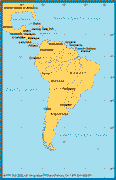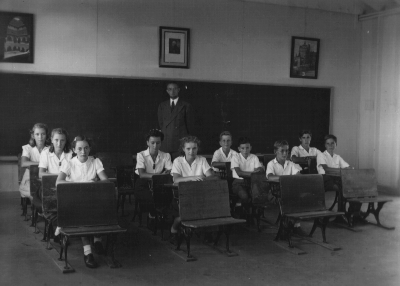

Purpose: The purpose of this web site to help bring down the "wall of silence" on the heretofore well-kept secret of the kidnapping, arrest, internment, and deportation by the United States Government (Department of Justice and Department of State), during and after World War II, of Latin Americans of German ancestry.
Facts: During the hearings before the U.S. Commission on Wartime Relocation and Internment of Civilians, Edward J. Ennis, the Director of the Alien Enemy Control during World War II, on November 3, 1981 testified:
Mr. Macbeth [a member of the Commission]: Did you have any experience with the internment of enemy aliens who were outside of the United States.Mr. Ennis: Oh yes, we had two programs...Now the other program was taking alien enemies from other countries in South America...If we couldn't get the [Latin American] countries to intern them we had to transmit them to the United States for internment...It was an aborted program, I don't think it accomplished anything. It had a security purpose to do in these countries [Latin America] what we were doing in the United States, about 5,000 German aliens were interned, and a few hundred German aliens in Cuba and in other countries in South America. But it didn't work very well. [Source: pp.157-159, Testimony of Edward J. Ennis before the Commission on Wartime Relocation and Internment of Civilians on November 3, 1981, R.G. 220
The June 28, 1942, Diario Costa Rica published the following:
BLACK LIST or 'PROCLAIMED LIST' for COSTA RICA To Costa Rican citizens and Allieds of the War Against the Totalitarians. Patriot Costa Ricans should not deal with people of businesses in the so called Black List or "Proclaimed List".--Do not buy from enemies of democracy, the money you spend will be used to attack yourself. We have to economically wipe out those who sympathize with the crimes of the Gestapo. War is death. Totally against them or with them. The Black List DIRECTIVA DE ACCION DEMOCRATICA COSTARRICENCE.
They went to far... An interoffice memorandum dated November 15, 1943 of the Division of the American Republics of the U.S. Department of State in regards to the arrest of twelve Costa Ricans of German ancestry, reads, in part, as follows:
Herewith [the names of twelve Costa Ricans] the kind of thing which I have been fearing and in my opinion may well rise to damn us when the present crisis is over.On November 23, 1943 a Laurance A. Knapp the Adviser on Political Relations, U.S. Department of State responds to the foregoing as follows:Our embassy in Costa Rica has sent a formal note to the Costa Rican Foreign Officer referring to the resolution of the CPD [Committee for Political Defense whose resolution was discussed and presented at a conference in Washington, D.C. from July 28 to August 10, 1943] and transmitting a list of enemy nationals which "has been approved by the Enemy Alien Control Unit of the United States Department of Justice for internment in the United States." In point of fact, I believe I recognize some of the names as those of Costa Rican nationals.
I believe that we should invite SD's [State Department] attention to the dangers of this course and that we should rap the Embassy sharply over the knuckles for such an indiscreet act.
I have talked to Mr. Cabot concerning the exact nature of his criticism. Precisely, it is that the note handed to the Foreign Minister smacks of intervention in its phrasing and that, in the circumstances prevailing vis-à-vis Costa Rica, it was probably unwise to employ this formal avenue of approach at all...On November 24, 1943 a Division of the American Republics, U.S. State Department memorandum reads, in part, as follows:
...I am not opposed to deportations [deportations of Latin Americans of German ancestry to the United States]in general; quite the contrary, as the record on Central America deportations would showThe Latin Americans of German ancestry who [about 5,000] were brought to this country by the United States were incarcerated in several camps, most were in either of the following camps: Crystal City, Texas; Seagoville, Texas; Camp Kenedy, Texas; Fort Lincoln, Bismarck, North Dakota; and Ellis Island, New York Harbor, New York.I think it would be highly desirable if the written record in each deportation case should show that the deporting Government had requested our collaboration.
I think it is undesirable for the written record to show that the initiative came from us.....
I fear that in the post-war period, unfriendly leaders in the other republics may use incidents such as this to demonstrate that behind the facade of Good Neighborship the United States was really interfering in the internal affairs of the other republics. I see no reason why we should give them written evidence to bolster such an assertion. If we really must take the initiative and exert pressure in connection with deportations, it should at least be done with discretion.
Hundreds of the interned Latin Americans, many of whom were, by birthright, citizens of one of the republics, were exchanged for persons of the Americas held by the Third Reich, i.e., they were deported to Germany
Stephen Fox, "The Deportation of Latin American Germans, 1941-47: Fresh Legs for Mr. Monroe's Doctrine," Yearbook of German-American Studies 32 (1997): 117-42.
Prior to the exchange, lists of internees in the U.S., including the names of German-Jews, were provided to the authorities of the Third Reich.
The State Department citations herein are included in their entirety
in Volume IV, The World War Two Experience of German-Americans of
German-Americans in the World Wars, Edited by: Don Heinrich Tolzmann, K.G.
Saur, Munich, 1995, pp. 1671-1674.
A source relating to the Germans of Guatemala, see Los Alemanes en
Guatemala 1828-1944 by Regina Wagner (Asociacion de Educacion y Cultura
'Alejandro von Humboldt' Comite de Investigaciones Historicas) Editorial
IDEA, La Universidad en su Casa, Universidad Francisco Marroquin, Guatemala,
1991.
My dear grandson I want to respond to your thought about our ejection from Peru, which only happened under American pressure. After Peru declared war on Germany, the government's goal was to break up trade with Germany, and to deport all German citizens, little by little. This started in 1942 and it was our "turn" to be arrested in 1944.
Your grandfather had been arrested in early March 1944. Early in the morning, without notice, he was picked up. My turn, together with your uncle [age 8] and your mother [age 22 months], came in September 1944. Our transport from Port Callao [October 11, 1944] was on a U.S. troopship [USAT COL Frederick C. Johnson], accordingly the accommodations were of a military nature. The ports of call and other descriptions of this voyage are cited in the next section of this site.
In the bottom deck of the ship where we slept, there were hammocks in three tiers, one on top of the other. Thick pipes crossed the deck of the ship where we slept. Of course, no windows on this level which was below the water level.
We ate our meal directly out of the cans while standing at a table made out of long wooden boards which were hung from the ceiling with chains. The bathrooms were quite primitive. Only salt water, and only enough for a small wash.
Luckily, the ship rushed on its journey, we were only at sea for ten days. When we disembarked at New Orleans [I believe] we were put aboard a Mississippi boat at taken up the river. The river trip was beautiful, but I have forgotten where we landed.
In the place where we landed there large halls wherein we were sprayed so as to be from lice, just in case. After this we met our husbands, boarded a train, and taken to the Crystal City, Texas Family Internment Camp.
Once per week we had control check in the camp. Thursday afternoons were set aside for head counts. Families had to form a line in front of their quarters; the camp commander and his wife would drive by slowly and check off their presence.
Life was pleasant in the camp except of course the thought of far reaching uncertainty of our future. There was constant threat and rumors of deportation to Germany. We wanted to return to Peru. After many hassles with the government officials an apparent decision was made to allow those who had resided in Peru for more than 30 years, or who had married Peruvians, or who had children born in Peru, to return to Peru. Your mother was our saving angel--because your mother was a Peruvian by birth we were allowed to begin a successful new beginning in Peru some time in 1946.
According to the ship's log this voyage sailed from Arica (10/7) to Callao (10/11) to Balboa (10/16) to Cristabol (10/17) to New Orleans (10/22), dates in ( ) are departure dates.
In his book Triangle of Hate, University of Washington Press, Seattle, 1981, C. Harvey Gardiner describes this voyage as follows:
Since numerous shiploads of internees from the west coast of South America had generated hundreds of complaints, one would expect considerable expertise in such operations after two and one-half years. However, the October [1944] voyage of the United States Army Transport (USAT) Frederick C. Johnson was freighted with unlimited potential for increased, not diminished, complaint.From the Bismarck Echo of October 29, 1944, the following excerpts were taken from the report of the voyage of the USAT COL Frederick C. Johnson. (The Bismarck Echo was the camp newspaper prepared by and edited by the German American internees of Fort Lincoln, North Dakota.) As a matter of information this October 29, 1944 report of the ship's ports of call by the internees is incredibly accurate. See page 2895 of Section 3, Volume IV of The World War Two Experience of German-Americans of German-Americans in the World Wars, Edited by: Don Heinrich Tolzmann, K.G. Saur, Munich, 1995The one time Hudson River vessel, converted to troop carrying, failed miserably when men, women, and children were involved. The enemy aliens occupied two holds. The women and children were quartered in the afterhold, a space approximately fifty by forty feet with bunks in tiers of four. Lacking guardrails of any kind those bunks were exceedingly dangerous for small children. To reach the afterhold one had to pass through the area occupied by the men. To enter the only latrine on the ship for their use, the women and children had to go through the men's quarters. Scheduling the use of the latrine by both sexes, plus the necessarily frequent closing of the area for cleaning, posed extremely unsatisfactory conditions. Drinking water was unavailable between 9 P.M. and 7 A.M., and during the entire voyage there was no fresh water for bathing or washing. pp. 107-108
100 sailors from other ships that had been bombarded also got on the transporter for "security matters." With all these people the little ship was obviously overcrowded.The sanitary provisions were terrible: there was only one bathroom which could be used during certain hours. The trip itself was challenged by a tornado and a submarine that already sunk another ship.
The ship reached New Orleans October 22nd. The passengers were taken to land on the same day and "after being released from their lice," the more comfortable part of the journey began.
Nicaragua
Other Black Lists developed by the United States of America
The following picture is of a class in the Crystal City, Texas internment camp--1945
